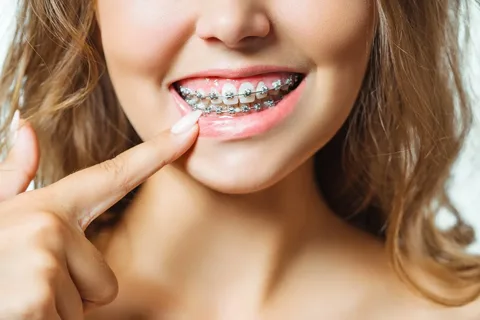Having a beautiful smile can boost your confidence and improve your oral health. One of the most effective ways to achieve this is through the use of teeth braces. In this article, we will explore the reasons why braces are used, delve into their historical background, and discuss the various types of braces, including modern advancements.
Why Are Braces Used?
Teeth braces, or orthodontic braces, are used to correct misaligned teeth and jaw issues. Here’s why they are so important:
- Alignment: Braces help align crooked or crowded teeth, making your smile more attractive.
- Bite Correction: They can fix overbites, underbites, and crossbites, ensuring your teeth fit together properly.
- Oral Health: Correcting misalignment prevents dental issues like cavities and gum disease, as it’s easier to clean straight teeth.
- Confidence Boost: A straight smile can boost your self-esteem and make you more comfortable with your appearance.
A Glimpse into History
The use of braces to straighten teeth dates back to ancient times. The first known braces were created by the ancient Egyptians around 2000 BC. They used metal wires to correct dental issues. However, modern braces, as we know them today, have come a long way.
In the 18th century, French dentist Pierre Fauchard made significant contributions to the dental world, such as the invention of dental braces. He used a horseshoe-shaped piece of metal with wires to correct dental alignment.
Braces continued to evolve over the centuries. In the 20th century, advances in materials and technology led to the creation of more effective and comfortable braces.
Types of Braces
There are several types of braces, each with its own set of advantages and considerations. Let’s explore some of the most common ones:
- Traditional Braces: These are the classic metal braces most people think of when they hear the word “braces.” They consist of metal brackets and wires and are highly effective for a wide range of orthodontic issues.
- Ceramic Braces: Similar in design to traditional braces but made from clear or tooth-colored materials, making them less noticeable.
- Lingual Braces: These braces are attached to the back of the teeth, making them virtually invisible from the front.
- Invisalign: A popular option for those seeking a discreet solution. Invisalign uses clear aligner trays to gradually shift teeth into the desired position.
- Self-Ligating Braces: These spacer braces use special brackets that don’t require elastic bands. They tend to reduce discomfort and treatment time.
- Customized Braces: Some orthodontists offer customized braces, designed to fit your specific dental needs and provide a more personalized treatment experience.
The Magic of Modern Braces
Modern braces have made significant advancements in terms of comfort, aesthetics, and efficiency. Here’s what makes them so special:
- Smaller and Sleeker: Traditional braces used to be bulkier, but modern braces are smaller and less obtrusive, offering more comfort and less irritation.
- Faster Treatment: Advancements in orthodontics have led to shorter treatment times with modern braces, reducing the duration of your orthodontic journey.
- Aesthetic Options: Clear or tooth-colored materials, like those used in ceramic and lingual braces, offer a more discreet appearance.
- Improved Hygiene: Some modern braces are designed with fewer nooks and crannies, making it easier to keep your teeth and braces clean.
- Digital Impressions: Digital technology has eliminated the need for messy, traditional impressions, making the process more comfortable for patients.
- Remote Monitoring: Some orthodontic practices now offer remote monitoring, allowing you to check in with your orthodontist from the comfort of your home.
The Braces Journey
Orthodontic treatment with braces typically involves several stages:
- Consultation: Your orthodontist will assess your dental issues and discuss the best treatment options with you.
- Placement: Braces are affixed to your teeth. The type of braces chosen will depend on your specific needs and preferences.
- Regular Adjustments: You’ll visit your orthodontist regularly for adjustments and check-ups to ensure your treatment progresses as planned.
- Oral Hygiene: Maintaining good oral hygiene is crucial during orthodontic treatment to prevent issues like cavities and gum disease.
- Brace Removal: Once your treatment is complete, your braces are removed to reveal your beautifully aligned smile.
Life with Braces
Living with braces may require some adjustments to your daily routine, but the benefits far outweigh the inconveniences:
- Dietary Changes: You’ll need to avoid certain foods that can damage your braces, like hard candies and sticky treats.
- Oral Care: Regular and thorough brushing and flossing are essential to maintain oral health.
- Discomfort: Some discomfort and soreness may occur after adjustments, but it’s a sign that your braces are working.
- Regular Appointments: Plan to visit your orthodontist as scheduled to ensure your treatment stays on track.
- Keep the End Goal in Mind: Remember that the end result – a beautiful, straight smile – is worth the effort.
Retainers: The Final Step
After your braces are removed, your orthodontist will recommend wearing a retainer. This crucial device ensures that your newly aligned teeth remain in their corrected positions. Retainers can be removable or fixed and are typically worn for a specified period.
The Importance of Oral Health
During your orthodontic journey, maintaining good oral hygiene is paramount. With braces, it’s essential to pay extra attention to cleaning your teeth, as food particles can get trapped in the brackets and wires. Regular check-ups and cleanings with your dentist will help ensure a healthy smile.
The Cost of Braces
The cost of orthodontic treatment with braces can vary based on several factors, including the type of braces, the complexity of the case, and your location. Many dental insurance plans offer coverage for orthodontic treatment, but it’s essential to understand the specifics of your policy. Some orthodontic practices also offer financing options to make braces more affordable.
Conclusion
Teeth braces have come a long way, offering effective solutions to correct misaligned teeth and enhance your oral health and confidence. With various types and modern advancements, you have the freedom to choose the best option for your specific needs and lifestyle. Embrace the journey, and soon you’ll be flashing a dazzling smile for the world to see, a testament to the wonders of modern orthodontics. Your beautiful smile is just an orthodontic treatment away!




